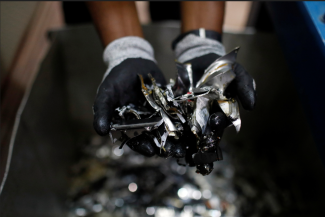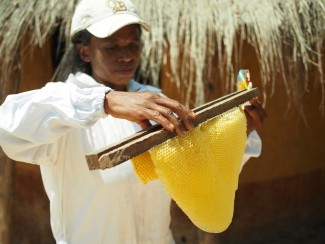|
|
|
Following the 2010 Nagoya Protocol on Access to Genetic Resources and the Fair and Equitable Sharing of Benefits Arising from their Utilization to the Convention on Biological Diversity (CBD), countries have been implementing this international regime that ensures that the utilisation of biodiversity-related traditional knowledge for research and development is fairly and equitably compensated.
While some industries like pharmaceuticals have been shifting their focus away from natural products drug discovery, to synthetically producing novel molecules, there are other industries that have come to the fore in access and benefit-sharing (ABS) and traditional knowledge contexts. Cosmetics and skin care, herbal supplements and “nutraceuticals,” novel foods, and related industries appear to be more likely to embrace and use marketing to emphasise their uses of traditional knowledge relating to natural plant-based or even animal-based products.
These can be important industries for Indigenous peoples and local communities, can provide a culturally appropriate source of income and livelihoods. However, it is important that there are appropriate benefits and fair payments, that Indigenous people have the opportunity to “value-add” beyond just raw materials, and also to protect their traditional knowledge.
Indigenous or traditional knowledge
It is widely recognised that the traditional knowledge of Indigenous peoples and local communities plays an important role in the development of natural products such as medicines, skin and body care products, foods and beverages, and other uses such as fibres.
This knowledge is sometimes widely published and well-known, it is sometimes held among many communities, it may be locally held or secret, and in some cases it is sacred. This knowledge of nature is also sometimes exchanged through songs, stories, artworks and folklore, and these are often called “traditional cultural expressions.”
It is also common to hear that Indigenous knowledge is being lost due to the effects of colonialism, modernisation, changing lifestyles and globalisation. If the knowledge is not passed on within families or communities, it sometimes dies out as elders and knowledge-holders pass away. This is a loss, not only for those communities, but also for society as a whole.
Valuing Indigenous contributions to innovation
In a number of international forums, there have been attempts not only to protect traditional knowledge from “misappropriation,” but also to help fairly and equitably value the contributions of Indigenous innovations and knowledge to value-added products on the global market.
The Nagoya Protocol and CBD help recognise these through a regime for the fair and equitable sharing of benefits when genetic resources (typically plant and animal components, or microbes) are used in research and development of products that are then often patented or trademarked to protect the value-addition.
Alongside the Nagoya Protocol, the World Intellectual Property Organization (WIPO) has its Intergovernmental Committee on Intellectual Property and Genetic Resources, Traditional Knowledge and Folklore (IGC), which has sought to also develop legal instruments for the protection and promotion of traditional knowledge. And in the World Trade Organization (WTO), some countries have sought to include checks and balances in the disclosures made by patent applicants, where they may have used genetic or biological resources and associated traditional knowledge in their innovations.
These negotiations in the WIPO IGC and WTO are still ongoing. The WIPO Voluntary Fund has been established and utilised to support the attendance of representatives from Indigenous peoples and local communities in the WIPO IGC negotiations, and most least developed countries are member states of WIPO and are able to attend and contribute to the negotiations shaping traditional knowledge policy globally.
Examples of established and emerging value chains
There are some examples of established value chains based on traditional knowledge of plants and their derivatives. The Moroccan Argan tree (Argania spinosa) now has a booming international demand for skin and hair care products which use the Argan oil. This oil has close to 1000 years of traditional use by Berber (Amazigh) women in Morocco, where the tree is endemic. Women’s cooperatives have been established which help the Amazigh women benefit from value addition through infrastructure development and quality improvements, as well as product development—for example prepared creams, soaps and shampoos rather than just selling oils. These have often benefited from fair trade schemes, donors providing equipment, as well as benefit-sharing agreements where other Argan-based products have been developed by cosmetic and skin care industries.
Nali nut or nangai (Canarium indicum) are found in South Pacific countries such as Vanuatu, Samoa and the Solomon Islands. (Photo ©Daniel Robinson)
In other parts of the world, there are emerging value chains for Indigenous peoples and local communities, such as demand for dilo nut or tamanu (Calophyllum inophyllum) and nali nut or nangai (Canarium indicum) which are found in countries in the South Pacific including Vanuatu, Samoa, Solomon Islands and Papua New Guinea. Countries are working with capacity development programs such as the Access and Benefit-Sharing Capacity Development Initiative (ABS Initiative) to establish better agreements for supply of raw oil extracts, as well as benefit-sharing where research and development is being conducted.
Another example includes the Kakadu plum (Terminalia ferdinandiana)—the world’s highest source of vitamin C, which is being used as a food additive and for antioxidant properties in cosmetics and other products. The industry is being developed by several Indigenous owned and led enterprises and Aboriginal corporations in remote parts of Northern Australia, with the support of the Indigenous Land and Sea Corporation. These enterprises have expressed that it is important that Indigenous people have control over decision-making about their value chains, and that they are able to value-add and protect their own innovations and products.
Mechanisms to protect and promote traditional knowledge
The continued role of Indigenous peoples and local communities and the importance of traditional and local knowledge has been acknowledged in the CBD post-2020 discussion paper, outlining concepts and seeking submissions on the post-2020 Global Biodiversity Framework.
It is important that the knowledge of Indigenous peoples and local communities is appropriately valued, protected and promoted, to support livelihoods, help protect the environment and sustain culture. Where this knowledge of plants and animals is used towards research and development of new products, there should be fair and equitable sharing of benefits, and there are opportunities here for Indigenous people to value-add and lead initiatives for the marketing of these products.
While intellectual property tools can be used such as patents—which can be jointly held in the case of partnerships—there may be other mechanisms to help protect and promote traditional knowledge, such as those options currently under discussion in the WIPO IGC.
-------
Daniel Robinson is Associate Professor at the University of New South Wales, Australia, and Pacific Regional Manager for the ABS Initiative. He is the co-editor of Protecting Traditional Knowledge: The WIPO Intergovernmental Committee on Intellectual Property and Genetic Resources. Margaret Raven is Scientia Fellow at the University of New South Wales, Australia.
Header image of Haitians playing basketball - ©UN Photo/Logan Abassi via Flickr Creative Commons Attribution-NonCommercial-NoDerivs 2.0 Generic (CC BY-NC-ND 2.0) license.
If you would like to reuse any material published here, please let us know by sending an email to EIF Communications: eifcommunications@wto.org.




